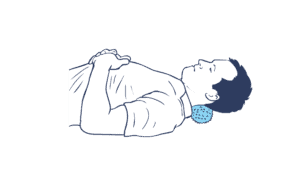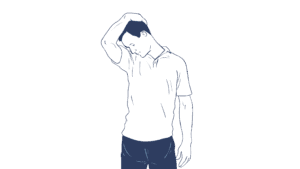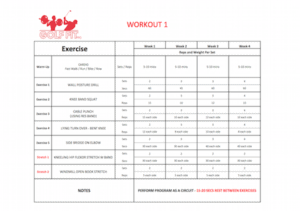exercise of the week
Author: Nick Randall
Neck pain in a common issue in modern populations, with the root cause often related to hours on end in a fixed forward head posture. This position leads to a shortening of the extensor muscles at the back of the neck and a weakening of the deep muscles in the front. The result is often pain and discomfort in the neck, sometimes accompanied by headaches.
From a golf perspective, the combination of a forward head position and a tight / weak neck presents a twofold issue for rotation in the backswing. Firstly, the head hanging forward and low inhibits our ability to rotate through our upper back because our spine is being pulled out of the neutral position from where is rotates most efficiently. Secondly, the tight muscles around the neck reduce the ability to rotate in our upper spine, often leading to unwanted head movement away from the ball in the backswing.
If you suffer from a tight neck and would rather play golf without pain and a shortened back swing, then try following the steps outlined below.
STEP 1 – SELF MASSAGE
Grab a spiky ball or similar massage tool, and place it under the ridge of your skull, to either the left of right of the spine. Support the weight of your head with a hand placed behind the head if needed, your neck muscles should be relaxed.
Slowly turn your head from left to right and nod up and down. Maintain a slow rhythm and aim for a deep massage. Every 20 seconds switch the position slightly and repeat until you have covered both sides.
STEP 2 – MASSAGE
Stretch 1 – Nose to armpit. Gently pull your nose down towards your armpit, feeling the stretch in back of your neck. Aim to stand tall throughout stretch, trying not to slump forward. Hold for 30 seconds each side.
Stretch 2 – Ear to Shoulder – Tilt your head to one side, moving ear towards shoulder, feeling stretch down the side of your neck. Add some light pressure to your head with the opposite hand. Hold for 30 seconds each side.
STEP 3 – STRENGTHEN DEEP NECK MUSCLES
The muscles responsible for holding your neck and head in good posture are deep in the front of the neck and strengthening them can be tricky. The best method I have used was taught to me by Carolyn Richardson of GravityFit.
Placing a piece of light resistance tubing (or the Gravity Cap) over the crown of your head, aim to push up against the tubing, drawing your spine out of your pelvis and standing stall. Retract your chin and feel the deep muscles in the front of your neck working. Hold for 30 seconds, rest for 10 seconds and repeat.
When performing any of these exercises, stop immediately if you feel dizzy or experience any strong pain.
You can check out more of Nick’s articles and services here:
For more great articles like this follow this link for a great time.
Co-authored by: Wisdom in Golf
About the Author:
Nick is a strength and conditioning coach contracted by PGA Tour Players and national teams to deliver his unique brand of golf fitness services. Nick offers the opportunity to access his knowledge and service offering to the rest of the golfing world through the following avenues:
So you’ve had the desire to improve your game and feel like it’s a good time to get busy with some physical training. Making a plan and getting a training program sorted out are next on the agenda, but you might feel a bit overwhelmed by the contrasting opinions and recommendations out there relating to golf fitness. If you are anything like the average golfer, then thoughts like this might be running through your head:
- Will I need to join a gym?
- How can I move my hips like Rory?
- Is stretching good for me or not?
- Should I get a trainer?
- Maybe I’ll get the “Ab Flex Twisty Turner Fat Shredder Pro 9?” (the answer is a definite NO to this one!)
All these doubts essentially boil down to four key questions
- What exercises are best for you?
- How many sets and reps should you do?
- When should you do them?
- How much load should you use?
Answering these four questions forms the nuts and bolts of constructing a training program. If we can figure out how to answer these questions best, then we are most of the way to getting you a decent training program.
What Exercises Are Best For You?
Everyone has an opinion on what exercises golfers should or shouldn’t do. If you listened to everybody you’d be either in the gym all day doing 73 different exercises per workout, or you’d be frozen to the spot thinking about why NOT to do them all!
A good rule of thumb is to include exercise variations of the following primal movements
- Squat, Lunge, Push, Pull, Bend/Hinge, Brace
You’ll also want to target improvements in the following areas:
- Strength
- Stability
- Mobility
- Posture
This will ensure a balanced workout that incorporates a range of different movements and improves the way your body performs during the golf swing.
How Many Sets and Reps Should You Do?
Again, opinions can be pretty polarized here. Some say do 5 reps for max strength or power, while others reckon that endurance is key and recommend doing 20 reps per set. I would advise to simply take the middle ground on this one. Aim for 8-to-12 reps and 2-to-3 sets and you can’t go too far wrong.
When Should You Do Them?
This really depends on a lot of your lifestyle and when you play golf during the week. Let’s use the example of someone who has some spare time during the week to exercise and plays their competitive round on a Saturday. In this case, go for three workouts per week and try to have a rest/recovery day on Friday. A schedule I often recommend is Monday, Tuesday, Thursday.
How Much Load Should You Use?
Imagine a scale of exertion and effort relative to how hard the last two reps are in a set. At one end of the scale, you are you are in danger of bursting blood vessels in your eyes. This is a 10. At the other end of the scale, you are not even close to breaking a sweat and could do 50 more reps if your life really depended on it. This is a 1. I would recommend aiming for 7 or 8 on the scale.
In terms of what type of load, I like the following progression relative to ability and experience:
- Bodyweight
- Bands
- Dumbbells
- Barbells
An Example
For a nice simple example of how this looks in program format, take a look at the image below. This is a workout taken from a beginner level program, a version of which I use with younger juniors and novice gym users to introduce them to training their body for golf.
It is well worth considering that this advice WILL NOT apply to everyone and program design should reflect your ability, experience, injuries and other individual peculiarities. It also should be known that as professionals, my contemporaries and I consider a few more factors to achieve a really top notch program:
- What levels of exercises are suitable?
- What exercise progressions to use and when?
- Which exercises go together (and which ones do not)?
- How much rest between sets?
- What tempo (speed) to perform the exercises at?
- What are the appropriate modifications to form and technique?
As you can see, designing a comprehensive golf fitness program by yourself is actually a pretty tricky task. Formal strength and conditioning education, extensive knowledge of the golf swing and plenty of experience are needed to properly answer all of the questions above.
If you would like to access training programs designed by a golf fitness expert, then check out the following products and services from Nick at Golf Fit Pro:
For more cool articles like click here and experience more wisdom form one of the best in the golf industry






